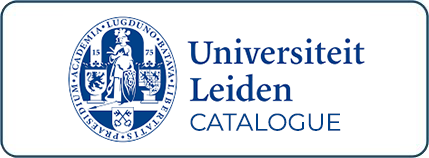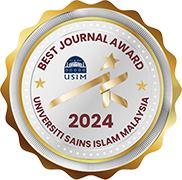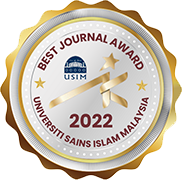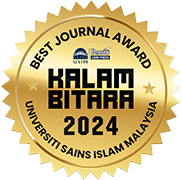قراءة في أدلّة النّسب في ضوء مباحث التّعبّد والتّعليل: دراسة تأصيليّة تحليليّة
AN EXAMINATION OF EVIDENCE OF LINEAGE IN THE LIGHT OF THEMES OF WORSHIP AND REASONING: A CONCEPTUAL AND ANALYTICAL STUDY
DOI:
https://doi.org/10.33102/mjsl.vol12no3.788Keywords:
Worship, reasoning, proof, denial, lineage, التعبد, التعليل, إثبات, نفي, النسبAbstract
The issue of lineage in Islamic jurisprudence has long attracted scholarly attention due to its relevance across various Fiqh chapters. As human knowledge, particularly in genetics, has advanced, this interest has evolved. Today, modern techniques like DNA testing can accurately establish lineage, prompting a need to evaluate whether such methods are valid for affirming, denying, or proving lineage. This requires a review of traditional legal evidences on lineage and an exploration of whether analogy (qiyās) can be applied to these contemporary methods, making this research highly significant. One of the most important perspectives through which this topic can be examined—and which has not received sufficient research and study—is the consideration of the legal texts related to lineage and the extent to which they are devotional or subject to reasoning, and thus whether analogy can be applied to them, which is the core issue of this research. According to the researchers’ knowledge, no study has yet been conducted that exclusively addresses this topic from this particular angle, thoroughly explores it, and sheds light on its complexities. To resolve this issue and achieve the objective of this study, the researchers gathered as many scholarly opinions as they could find regarding the evidences for lineage and assessed them through the lens of ta‘abbud (devotion) and ta‘līl (rationalization) using an inductive method. They then proceeded to analyze and explore these opinions and evidences, grounding them in jurisprudential foundations. Afterward, they reconstructed their findings into a clear and well-defined framework. This led them to the conclusion that there is only one definitive proof for establishing lineage, which is the valid marriage— despite differences among scholars regarding its precise meaning. Some defined it as merely the contract between a man and a woman, others as the possibility of consummation, while a third group held that actual consummation must have occurred. Any other forms of evidence serve only to reveal lineage. The study also concluded that there is only one definitive proof for disavowing lineage, which is the dālīl al-li‘ān (the procedure of mutual cursing). The Ḥanafī school held that the proof for establishing lineage is based on ta‘abbud (devotional compliance), while the majority of scholars believed it to be based on ta‘līl (rationalization). The majority then differed regarding the rationale: most confined it to legitimate marital relations (firāsh shar‘ī), whereas some extended it to any situation where the rationale is present, as long as it is not contradicted by established legitimate marital relations. Similarly, scholars differed in their views on the evidences for revealing lineage. Finally, the researchers concluded that the proof for disavowing lineage—liʿān—is considered taʿabbudi (devotional) according to some scholars, while others view it as rationalized (muʿallal) by a limited rationale. In both cases, it cannot be extended or analogized. Based on this, the study contributes to regulating and establishing the foundations for all contemporary methods used in determining lineage. Accordingly, the researchers recommend reconsidering all issues related to lineage determination through modern methods and aligning them with the conclusions reached in this study.
ملخص
مسألة النّسب في الفقه الإسلامي مِن المسائل التي حَظيت باهتمام كبير مِن العلماء؛ نظرًا لارتباطها بالعديد مِن أبواب الفقه. وتجدد الاهتمام بها مع تطور العلوم الوراثية، خاصة مع اكتشاف الحمض النووي (DNA) وقدرته على تحديد النسب، الأمر الذي يتطلب بحثًا عن مدى اعتبار مثل هذه الوسائل المعاصرة في إثبات النسب، أو إظهاره، أو نفيه؛ وهذا بدوره يتطلب دراسة للأدلة الشرعية للنسب ومعرفة إمكانية القياس عليها مِن عدمه، وبهذا تظهر أهمية هذه الدراسة. ولعل مِن أهم الزوايا التي يُنظَر إلى هذا الموضوع مِن خلالها -والتي لم تحظَ ببحث ودراسة كافيَين- النّظر في نصوص الشارع المتعلقة بالنسب، وإدراك مدى تعبديتها من تعليلها، وبالتالي إمكان القياس عليها مِن عدمه، وهنا تَكْمُن مشكلة هذا البحث؛ إذ إنّه لا تتوفر -بحسب اطلاع الباحثَين- دراسة مستقلة تتناول الموضوع مِن هذه الزاوية وتحيط به وتزيل الغبار عنه. وعليه فقد قام الباحثان بجمع ما استطاعا الوصول إليه مِن أقوال للعلماء حول أدلة النسب، وتكييفها في ضوء مباحث التعبد والتعليل عبر منهج استقرائي، ثم عَمَدا إلى ما جمعاه مِن أقوال ودلائل وقاما بتحليلها والتأصيل لها، ثم أعادا تركيبها في صورة واضحة المعالم، مكتملة البناء؛ توصلا مِن خلالها إلى أنَّ للنسب دليل واحد يثبت به وهو دليل الفراش -على اختلاف بين العلماء في معناه-. وما عداه مِن أدلة فإنما هي لإظهار النسب. كذلك دليل نفي النسب واحد وهو دليل اللعان. وقد ذهب الحنفية إلى تعبدية دليل إثبات النسب، بينما ذهب جمهور العلماء إلى تعليله، ثم اختلف الجمهور في هذه العلة فجعلها أكثرهم مقتصرة على الفراش الشرعي، بينما ذهب البعض إلى تعديتها إلى كل حالة توفرت فيها العلة ما لم يعارضها فراش شرعي ثابت. وبنفس الطريقة اختلفت آراء العلماء في أدلة إظهار النسب. وأخيرًا فقد تَبيَّن للباحثَين أنّ دليل نفي النسب -اللعان- تعبدي على رأي بعض العلماء، بينما هو معلل بعلة قاصرة على رأي فريق آخر، وهو في كلا الحالتين لا يمكن تعديته ولا القياس عليه. وبناء على ما سبق فإنّ هذا البحث يسهم في ضبط كافة الوسائل المعاصرة المستخدمة في التعرف على النسب ويؤصل لها. وعليه فإنّ الباحثَين يوصيان بإعادة النظر في كافة المسائل المبنية على تحديد النسب مِن خلال الوسائل المعاصرة، وبنائها على ما توصل إليه هذا البحث من نتائج.
Downloads
References
Abā Ḥusayn, A. M. M. (2015). Ithbāt al-nasab bi-al-baṣmah al-wirāthīyah baʻda nafīhi bāllʻān: dirāsah fiqhīyah. Majallat al-Jamʻīyah al-fiqhīyah al-Saʻūdīyah, 21(1), 421-510.
Abd al-Ṣamad, D., & Alī al-Qabāṭī, M. (2017). Nasab Wuld al-zinā: dirāsah fiqhīyah fī ḍawiʼ Maqṣad ḥifẓ al-nasl. Majallat al-ʻUlūm al-Islāmīyah al-Dawlīyah, Jāmiʻat al-Madīnah al-ʻĀlamīyah, 1(2), 105-139.
Ain Aziz, S. N., Razaly, M. Z., Othman, N., Saja@Mearaj, M., Yaakob, A. N., & Md Nawo. S. (2019). Attribution of illegitimate child’s nasb to the biological father: Analysis from the perspective of Malaysian Law, Muzakarah Fatwa Committee, State Fatwas and Maqasid Al-Shariah. Insight Journal 8, 217- 234. https://doi.org/10.24191/ij.v8i0.104
Al- Kashnāwī, H. A. (n.d.). Asʹhal al-madārik sharḥ Irshād al-sālik fī madhhab Imām al-aʼimmah Mālik. Dār al-Fikr.
Al-Āmidī, A. M. (1404). Al-Iḥkām fī uṣūl al-aḥkām. Dār al-Kitāb al-ʻArabī.
Al-ʻAṭṭār, H. (n.d.). Ḥāshiyat al-ʻAṭṭār ʻalá jamʻi al-jawāmiʻ. Dār al-Kutub al-ʻIlmīyah.
Al-azrirāni al-Ḥanbalī, A. A. M. (1431). Īḍāḥ al-Dalāʼil fī al-firaq bayna al-masāʼil. Dār Ibn al-Jawzī.
Al-Bahūtī, M. Y. (2008). Kashshāf al-Qināʿ ʿan al-Iqnāʿ. Wizārat al-ʿAdl fī al-Mamlakah al-ʿArabiyyah al-Suʿūdiyyah.
Al-Bakrī, U. M. (1995). Ḥāshiyat Iʻāʻnat al-ṭālibīn ʻalá ḥall alfāẓ Fatḥ al-Muʻīn li-sharḥ Qurrat al-ʻAyn bi-muhimmāt Al-Dīn. Dār al-Kutub al-ʻIlmīyah.
Al-bujayramī, S. M. U (1996). Tuḥfat al-Ḥabīb ʻalá sharḥ al-Khaṭīb. Dār al-Kutub al-ʻIlmīyah.
Al-Bukhārī, M. I. (1437). Ṣaḥīḥ al-Bukhārī. ʿAṭāʾāt al-ʿIlm.
Al-Dasūqī, M. A. A. (n.d.). Ḥāshiyat al-Dasūqī ʻalá al-sharḥ al-kabīr. Dār al-Fikr.
Al-Ghazālī, M. M. (1417). Al-Wasīṭ fī al-madhhab. Dār al-Salām.
Al-Ghazālī, M. M. (1971). Shifāʼ al-ghalīl fī bayān al-shubah wāl mukhayal wa-masālik al-Taʻlīl. Maṭbaʻat al-Irshād.
Al-Ghazālī, M. M. (1997). Al-Mustaṣfá fī ʻilm al-uṣūl. Muʼassasat al-Risālah.
Al-Izz ibn ʻAbd al-Salām, I. A. (1999). Qawāʻid al-aḥkām fī maṣāliḥ al-anām. Dār al-Kutub al-ʻIlmīyah.
Al-Jaṣṣāṣ. (2010). Sharḥ Mukhtaṣar al-Ṭaḥāwī. Dār al-Bashāʼir al-Islāmīyah.
Al-Jawharī, I. M. (1987). Al-ṣiḥāḥ Tāj al-lughah wa-ṣiḥāḥ al-ʻArabīyah. Dār al-ʻIlm lil-Malāyīn.
Al-Jazarī, M. Y. (1993). Miʻrāj al-Minhāj sharḥ Minhāj al-wuṣūl ilá ʻilm al-uṣūl lil-Qāḍī al-Bayḍāwī. Maṭbaʿat al-Ḥusayn al-Islāmiyyah.
Al-Jurjānī, A. M. (1985). Al-taʻryfāt. Maktabat Lubnān.
Al-Juwaynī, A. A. (1399). Al-burhān fī uṣūl al-fiqh. Qaṭar.
Al-Kāsānī, M. (1328). Badāʼiʻ al-ṣanāʼiʻ fī tartīb al-sharāʼiʻ. Maṭbaʻat al-Jamālīyah.
Al-khaṭāby, H. M. I. (1932). Maʻālim al-sunan. al-Maṭbaʻah al-ʻIlmīyah.
Al-Maqdisī, A. I. (2003). Al-ʻUddah sharḥ al-ʻUmdah, fī fiqh Imām al-Sunnah Aḥmad ibn Ḥanbal. Dār al-ḥadīth.
Al-Marīnī, A. (2002). Al-qawāʻid al-uṣūlīyah ʻinda al-Imām al-Shāṭibī min khilāl kitābihi al-Muwāfaqāt. Dār Ibn al-Qayyim.
Al-Māwardī, A. M. M. H. (1999). Al-Ḥāwī al-kabīr fī fiqh madhhab al-Imām al-Shāfiʻī. Dār al-Kutub al-ʻIlmīyah.
Al-Namlah, A. A. (1999). Al-Muhadhdhab fī ʻilm uṣūl al-fiqh al-muqāran. Maktabat al-Rushd.
Al-Nasfī, A. A. (2011). Kanz al-daqāʼiq. Dār al-Bashāʼir al-Islāmīyah wa-Dār al-Sarrāj.
Al-qādī ‘iyād, M. I. (1998). Ikmāl al-Muʿallim bi-Fawāʾid Muslim. Dār al-Wafāʾ li-Ṭ-Ṭibāʿah wa-N-Nashr wa-T-Tawzīʿ.
Al-Rāzī, M. A. A. (1994). Mukhtār al-ṣiḥāḥ. Dār al-Kutub al-ʻIlmīyah.
Al-Rāzī, M. U. (1400). Al-Maḥṣūl fī ʻilm al-uṣūl. Jāmiʻat al-Imām Muḥammad ibn Saʻūd al-Islāmīyah.
Al-Sabtī, I. M. I. (1998). Ikmāl al-Muʻallim bi-fawāʼid muslim. Dār al-Wafāʼ lil-Ṭibāʻah wa-al-Nashr wa-al-Tawzīʻ.
Al-Sarakhsī, M. A. (n.d.). Tamhīd al-Fuṣūl fī al-uṣūl. Dār al-Maʻrifah.
Al-Sarakhsī, M. A. A. (n.d.). Al-Mabsūṭ. Dār al-Maʻrifah.
Al-Ṣāwī, A. M. (1962). Ḥāshiyat al-Ṣāwī ʻalá al-sharḥ al-Ṣaghīr. Maktabat Muṣṭafá al-Bābī al-Ḥalabī.
Al-Shawkānī, M. A. A. (1993). Nayl al-awṭār sharḥ Muntaqá al-akhbār. Dār al-ḥadīth.
Al-Shīrāzī, I. A. Y. (n.d.). Al-Muhadhdhab fī fiqh al-Imām al-Shāfiʻī. Dār al-Kutub al-ʻIlmīyah.
Al-Shirwānī, A., & Al-ʻAbbādī, A. Q. (1996). Ḥawāshī al-Shirwānī wa-Ibn Qāsim al-ʻAbbādī ʻalá Tuḥfat al-muḥtāj bi-sharḥ al-Minhāj. Dār al-Kutub al-ʻIlmīyah.
Al-Subkī, A. A. (1404). Al-Ibhāj fī sharḥ al-Minhāj ʻalá Minhāj al-wuṣūl ilá ʻilm al-uṣūl li al-bayḍāwi. Dār al-Kutub al-ʻIlmīyah.
Al-Taftāzānī, M. U. (1996). Sharḥ al-Talwīḥ ʻalá al-Tawḍīḥ li-matn al-Tanqīḥ fī uṣūl al-fiqh. Dār al-Kutub al-ʻIlmīyah.
Al-Ṭūfī, S. A. A. (1987). Sharḥ Mukhtaṣar al-Rawḍah. Muʼassasat al-Risālah.
Al-Zarkashī, M. A. B. (2000). Al-Baḥr al-muḥīṭ fī uṣūl al-fiqh. Dār al-Kutub al-ʻIlmīyah.
Al-Zinkī, S. Q. (2007). Al-Buʻd altʻbdy fī al-tashrīʻ al-Islāmī min manẓūr uṣūlī. Majallat al-Dirāsāt al-Islāmīyah, Majmaʻ al-Buḥūth al-Islāmīyah, 42(4),163-197.
Al-Zubaydī, M. M. A. (1994). Tāj al-ʻarūs min Jawāhir al-Qāmūs. Maṭbaʻat Ḥukūmat al-Kuwayt.
Burqaʻh, S. U. (2007). Al-nasab wa-madá Taʼthīr al-mustajaddāt al-ʻIlmīyah fī ithbāth-dirāsah fiqhīyah taḥlīlīyah. Dār Kunūz Ishbīliyā lil-Nashr wa-al-Tawzīʻ.
Elfia, E., Surwati, S., & Fajri, Y. (2021). Kewarisan beda agama di Nagari Persiapan Bancah Kariang kecamatan kinali kabupaten pasaman barat. Al-ISTINBATH Jurnal Hukum Islam, 6(2), 341–341. https://doi.org/10.29240/jhi.v6i2.3479
Hasan, M., Ma’u, D. H., & Muallim. (2024). Inheritance property distribution models among the Muslim community of Borneo-Nusantara. Al-Adalah, 21(175-198).
Hilālī, S. M. (2010). Al-Biṣmah al-Warāthiyyah wa-ʿAlāʾiqahā al-Sharʿiyyah: Āfāq Fiqhiyyah wa-Qānūniyyah Jadīdah, Dirāsah Muqāranah. Maktabat Wahbah.
Ibn al-ʻArabī, M. A. (2003). Aḥkām al-Qurʼān. Dār al-Kutub al-ʻIlmīyah.
Ibn al-Qaṣṣār, A. U. A. (2006).ʿUyūn al-Adillah fī Masāʾil al-Khilāf bayna Fuqahāʾ al-Amṣār. Jāmiʿat al-Imām Muḥammad b. Suʿūd al-Islāmiyyah.
Ibn ʻĀshūr, M. A. (2015). Jamharat maqālāt wa-rasāʼil al-Shaykh al-Imām Muḥammad al-Ṭāhir Ibn ʻĀshūr. Dār al-Nafāʼis.
Ibn Ḥajar al-Haytamī, A. M. A. (2001). Tuḥfat al-muḥtāj bi-sharḥ al-Minhāj. Dār al-Kutub al-ʻIlmīyah.
Ibn manẓūr, M. M. (n.d.). Lisān al-ʻArab, Dār al-Maʻārif.
Ibn Mawdūd al-Mawṣilī, A. M. (1937). Al-Ikhtiyār li-taʻlīl al-Mukhtār, ʻalayhi taʻlīqāt: Maḥmūd Abū daqīqah. Maṭbaʻat al-Ḥalabī.
Ibn Qāḍī Shuhbah, M. A. (2011). Bidāyat al-muḥtāj fī sharḥ al-Minhāj. Dār al-Minhāj.
Ibn Qayyim al-Jawzīyah, M. A. A. (2019). Al-ṭuruq al-Ḥikamīyah fī al-siyāsah al-sharʻīyah. Dār ʻaṭāʼāt al-ʻIlm.
Ibn Qayyim al-Jawzīyah, M. A. A. (2019). Ighāthat al-lahfān min maṣāyid al-Shayṭān. Dār ʻaṭāʼāt al-ʻIlm.
Ibn Qayyim al-Jawzīyah, M. A. A. (2019). Zād al-maʻād fī Hudá Khayr al-ʻibād. Dār ʻaṭāʼāt al-ʻIlm.
Ibn Rushd, M.A. M. (2004). Bidāyat al-mujtahid wa-nihāyat al-muqtaṣid. Dār al-ḥadīth.
Majmūʻah min al-ʻulamāʼ. (2004). Al-Muʻjam al-Wasīṭ, Maktabat al-Shurūq al-Dawlīyah.
Mannun, I. (1345). Nibrās al-ʻuqūl. Maṭbaʻat al-Taḍāmun al-akhwaī.
Mohd. Shariff, A. A., Azhar, A., Rajamanickam, R., Abdul Manap, N., Mohd Hussein, S., Md. Said, M. H., Ab Halim, A. H., & Markom, R. (2019). Analysis on admissibility of DNA evidence in Malaysian Syariah Courts. Academic Journal of Interdisciplinary Studies, 8(4), 159-169. https://www.richtmann.org/journal/index.php/ajis/article/view/10621
Muslim, A. (1955). Ṣaḥīḥ Muslim. Dār Iḥyāʾ al-Turāth al-ʿArabī.
Salhab, R. M. (2010). Al-qiyās fī al-ʻibādāt wa-taṭbīqātuhu fī al-madhhab alshāfiʻy-dirāsah taʼṣīlīyah taṭbīqīyah. Dār ibn hazm.
Shalabī, M. M. (1947). Taʻlīl al-aḥkām, Maṭbaʻat al-Azhar.
Shalabī, M. M. (n.d.). Uṣūl al-fiqh al-Islāmī, al-Dār al-Jāmiʻīyah lil-Ṭibāʻah wa-al-Nashr.
Sibarani, W. (2023). Modern justice: Indonesia’s supreme court’s challenges to uphold fair trial principles through digitalization. Brawijaya Law Journal, 10(1), 106–121. https://doi.org/10.21776/ub.blj.2023.010.01.07
Sulaymān, R. S. Y. (2003). Al-Taʻlīl bi-al-ḥikmah, [Risālah jāmiʻīyah quddimat astkmālan li-mutaṭallabāt darajat al-mājistīr fī al-fiqh wa-al-tashrīʻ, Jāmiʻat al-Najāḥ al-Waṭanīyah]. Jāmiʻat al-Najāḥ al-Waṭanīyah Archive. https://hdl.handle.net/20.500.11888/3195
Zaydān, A. A (1996). Al-Wajīz fī uṣūl al-fiqh, Muʼassasat al-Risālah.
Downloads
Published
Issue
Section
Categories
License
Copyright (c) 2025 Belal Barakat Sulaiman Salhab, Sayyed Mohamed Muhsin

This work is licensed under a Creative Commons Attribution-NonCommercial 4.0 International License.














































